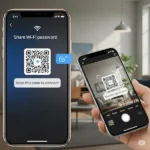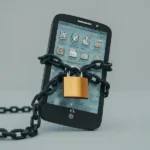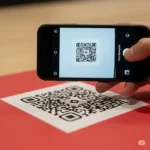Seamlessly Shift Your Digital Life: A Comprehensive Guide to Phone File Transfer Across Devices
In our increasingly connected world, switching phones or sharing data between different devices is a common occurrence. Whether you’re upgrading, borrowing a friend’s device, or just need to move a few photos, knowing how to transfer files efficiently is a vital skill. This E-A-T (Expertise, Authoritativeness, Trustworthiness) article will guide you through the various methods for transferring files between iPhones, Androids, and even cross-platform, along with essential troubleshooting tips and frequently asked questions. Learn how to do a phone file transfer between all types of devices.
iPhone to iPhone Transfer: The Apple Ecosystem’s Strengths
Apple has designed its ecosystem to make switching between iPhones incredibly smooth.
1. Quick Start (New iPhone Setup): This is the easiest method for setting up a new iPhone and transferring almost everything from your old one.
- How it works: When you turn on your new iPhone and place it near your old one (running iOS 11 or later), a “Quick Start” prompt will appear on your old device. You’ll then scan an animation on your new iPhone with your old one’s camera, enter your old device’s passcode, and follow the on-screen instructions. You’ll have the option to “Download from iCloud” or “Transfer Directly from iPhone.”
- What it transfers: Apps, app data, photos, videos, contacts, messages, settings, and more.
- Pros: Extremely user-friendly, comprehensive transfer, largely automated.
- Cons: Requires both devices to be physically close and connected to Wi-Fi.
- Credible Source: Use Quick Start to transfer data to a new iPhone or iPad – Apple Support
2. iCloud Backup & Restore: If Quick Start isn’t an option or you’re restoring a new device from a previous backup, iCloud is your go-to.
- How it works: On your old iPhone, go to
Settings > [Your Name] > iCloud > iCloud Backupand ensure “iCloud Backup” is enabled. Tap “Back Up Now.” On your new iPhone, during setup, select “Restore from iCloud Backup” and sign in with your Apple ID. - What it transfers: Apps, app data, photos (if iCloud Photos is enabled), messages, contacts, device settings, and more.
- Pros: Cloud-based, allows for restoration anytime, anywhere with Wi-Fi.
- Cons: Requires sufficient iCloud storage (free tier is limited), can be slower depending on internet speed and backup size.
3. AirDrop: For quick, wireless transfers of individual files or a small batch of content between nearby iPhones.
- How it works: Open the file (photo, document, etc.) you want to share, tap the share icon, and select “AirDrop.” Choose the receiving iPhone from the list of nearby devices. The recipient will need to accept the transfer.
- What it transfers: Photos, videos, documents, links, and more.
- Pros: Fast, convenient, no internet connection required (uses Wi-Fi and Bluetooth).
- Cons: Only works for devices in close proximity, not ideal for large-scale transfers.
Android to Android Transfer: Diverse Options for Flexibility
Android offers a variety of methods, often leveraging Google’s services or manufacturer-specific tools.
1. Google Backup & Restore: The most universal Android-to-Android transfer method, relying on your Google Account.
- How it works: On your old Android, ensure “Google Backup” (often found in
Settings > System > BackuporSettings > Google > Backup) is enabled and back up your data. When setting up your new Android, sign in with the same Google Account and choose to restore from a backup. - What it transfers: Apps, app data (for some apps), contacts, call history, Wi-Fi passwords, device settings, and photos/videos (if Google Photos backup is enabled).
- Pros: Simple, cloud-based, works across most Android devices.
- Cons: May not transfer all app data, requires Google Photos for comprehensive media backup.
- Credible Source: Copy apps & data from an Android to a new Android device – Google Help
2. Manufacturer-Specific Transfer Tools: Many Android manufacturers provide their own migration tools for a more seamless experience between their devices.
- Examples:
- Samsung Smart Switch: Excellent for Samsung to Samsung transfers, supporting both wireless and wired connections. It can transfer a wide range of data, including messages, call logs, app data, and even WhatsApp chat history.
- Credible Source: Smart Switch – Switching & Transferring Phone Data | Samsung UK
- OnePlus Switch (Clone Phone): Similar to Smart Switch, designed for OnePlus devices.
- Google’s “Set up new device” (during initial setup): Often prompts you to connect your old Android wirelessly or via cable to transfer data directly.
- Samsung Smart Switch: Excellent for Samsung to Samsung transfers, supporting both wireless and wired connections. It can transfer a wide range of data, including messages, call logs, app data, and even WhatsApp chat history.
- What they transfer: Often more comprehensive than Google Backup, including system settings, app arrangements, and sometimes even files not typically backed up by Google.
- Pros: Optimized for specific brands, often more complete transfers.
- Cons: Limited to devices from the same manufacturer, may not be compatible with all older models.
3. Nearby Share: Android’s answer to AirDrop, ideal for quick, local file sharing.
- How it works: On both devices, enable Nearby Share (found in Quick Settings or
Settings > Google > Devices & sharing > Nearby Share). Open the file you want to share, tap the share icon, select “Nearby Share,” and choose the receiving device. - What it transfers: Photos, videos, documents, links, and more.
- Pros: Fast, convenient, no internet connection needed (uses Wi-Fi Direct and Bluetooth).
- Cons: Both devices must be in close proximity.
4. Third-Party File Transfer Apps (e.g., Xender, SHAREit, Send Anywhere, AirDroid): These apps offer cross-platform capabilities but are also excellent for Android-to-Android transfers.
- How it works: Install the app on both devices, create a connection (often via a QR code scan or hotspot), and then select files to transfer.
- What it transfers: Almost any file type, including large media files.
- Pros: Fast transfer speeds, no internet connection required for direct transfer, often user-friendly interfaces.
- Cons: May contain ads (in free versions), some apps have privacy concerns.
iPhone to Android Data Transfer: Bridging the Divide
This is where things can get a bit trickier, as the two operating systems are fundamentally different.
1. Google’s Switch to Android App: Google’s official app designed to simplify the migration from iOS to Android.
- How it works: Install the “Switch to Android” app on your iPhone. On your new Android device, during setup, select to transfer data from an iPhone and follow the on-screen prompts. You may need a USB-C to Lightning cable or perform the transfer wirelessly.
- What it transfers: Contacts, photos, videos, messages (including iMessage history if transferring via cable), WhatsApp chats, and more.
- Pros: Official Google solution, streamlined process, good for initial setup.
- Cons: Best used during initial Android setup, may require a specific cable for full data transfer. Remember to disable iMessage on your iPhone after the transfer to avoid missing messages.
- Credible Source: Switch From iPhone to Android Seamlessly – Android
2. Cloud Services (Google Photos, Google Drive, Dropbox, OneDrive): For photos, videos, and documents, cloud services are a reliable cross-platform solution.
- How it works: On your iPhone, upload your desired files to your chosen cloud service. On your Android, download the corresponding app and access your files.
- What it transfers: Photos, videos, documents, and other files you manually upload.
- Pros: Flexible, accessible from anywhere with an internet connection, preserves file quality.
- Cons: Requires internet access, transfer speed depends on internet speed and file size, may require paid storage for large amounts of data.
3. Transfer via Computer: A slightly more manual but effective method for media and documents.
- How it works:
- iPhone to Computer: Connect your iPhone to your computer. For photos/videos, you can usually import them directly. For other files, you might need iTunes (for music/videos purchased through iTunes without DRM) or third-party tools (like iMazing, TouchCopy).
- Computer to Android: Connect your Android to your computer. It will typically appear as a removable drive. Simply drag and drop your files.
- What it transfers: Photos, videos, music, documents.
- Pros: Good for large media libraries, direct control over which files are moved.
- Cons: More steps involved, requires a computer, may be slower for very large libraries.
4. Third-Party File Transfer Apps (e.g., Send Anywhere, AirDroid, SHAREit): These apps can often bridge the gap between iOS and Android.
- How it works: Install the app on both devices, establish a connection (often via a QR code or code), and transfer files wirelessly.
- What it transfers: A wide variety of file types.
- Pros: Convenient, often faster than cloud services for local transfers.
- Cons: Can be ad-supported, some apps may collect user data.
Android to iPhone Data Transfer: Apple’s Move to iOS App
Apple provides a dedicated app to help Android users transition to iPhone.
1. Move to iOS App: Apple’s official app designed for a smooth migration.
- How it works: During the initial setup of your new iPhone, when you reach the “Apps & Data” screen, choose “Move Data from Android.” On your Android device, download and open the “Move to iOS” app. Follow the on-screen instructions, including entering a code displayed on your iPhone into your Android.
- What it transfers: Contacts, message history, camera photos and videos, web bookmarks, mail accounts, WhatsApp messages and media, Voice Memos, call history, and calendars. It will also attempt to find free apps that you have on Android in the App Store.
- Pros: Apple’s official solution, streamlines the process for new iPhone users.
- Cons: Only works during initial iPhone setup (if you’ve already set up your iPhone, you’ll need to erase it and start over), doesn’t transfer all data (e.g., music, paid apps, custom ringtones).
- Credible Source: Move from Android to iPhone or iPad – Apple Support
2. Cloud Services (Google Photos, Google Drive, Dropbox, OneDrive): As with iPhone to Android, cloud services are excellent for transferring media and documents.
- How it works: Ensure your photos and videos on Android are backed up to Google Photos or another cloud service. On your iPhone, download the respective app and sign in to access your files.
- What it transfers: Photos, videos, documents.
- Pros: Flexible, accessible, good for media.
- Cons: Requires internet connection, may need to pay for larger storage.
3. Manual Transfer via Computer: A reliable if less automated approach.
- How it works:
- Android to Computer: Connect your Android to your computer and copy the desired files (photos, music, videos, documents).
- Computer to iPhone: Use iTunes or Finder (on Mac) to sync music and videos. For photos, you can sync them through iTunes/Finder or use iCloud Photos. For documents, apps like Files on iOS and third-party file managers can help.
- What it transfers: Music, photos, videos, documents.
- Pros: Good for large media collections, complete control.
- Cons: More steps, requires a computer, can be time-consuming.
- Credible Source: Move content manually from your Android device to your iPhone or iPad – Apple Support
4. Third-Party File Transfer Apps (e.g., Send Anywhere, AirDroid, SHAREit): These apps provide a direct wireless transfer method.
- How it works: Install the app on both devices, establish a connection, and transfer files.
- What it transfers: Various file types.
- Pros: Convenient, often fast for local transfers.
- Cons: Potential for ads, some apps may have data privacy considerations.
Troubleshooting Common Problems of Phone File Transfer
Even with the best tools, file transfer can sometimes hit a snag. Here are some common issues and how to address them:
- Transfer is Stuck or Extremely Slow:
- Check Wi-Fi connection: Ensure both devices are connected to a strong, stable Wi-Fi network.
- Restart both devices: A simple restart can often resolve temporary glitches.
- Use a cable: Wired transfers (if supported) are almost always faster and more reliable than wireless for large data amounts.
- Reduce data size: If transferring wirelessly, try transferring smaller batches of files.
- Ensure sufficient storage: Verify that your new device has enough free space for the incoming data.
- Messages Not Transferring (especially from iPhone to Android):
- Disable iMessage: Before transferring from an iPhone to an Android, it’s crucial to disable iMessage on your iPhone. Go to
Settings > Messagesand turn off iMessage. This prevents messages from being sent to your old iPhone via Apple’s servers instead of reaching your new Android. You may also need to deregister your number from iMessage on Apple’s website.
- Disable iMessage: Before transferring from an iPhone to an Android, it’s crucial to disable iMessage on your iPhone. Go to
- Certain Apps or App Data Not Transferring:
- App compatibility: Not all apps are available on both platforms, and app data is often not directly transferable between iOS and Android.
- In-app backup/restore: Some apps (like WhatsApp) have their own in-app backup and restore features that must be used separately.
- Cloud sync for app data: For some apps, data might be synced through their own cloud service (e.g., game progress tied to a developer account).
- Photos/Videos Missing or Low Quality:
- Cloud sync settings: Ensure your cloud photo service (e.g., iCloud Photos, Google Photos) is set to upload original quality files.
- Check download settings: On the new device, ensure you’re downloading original files, not optimized or low-resolution versions.
- Verify backup completion: Double-check that the backup process on the old device completed successfully.
- “Move to iOS” or “Switch to Android” App Issues:
- Ensure both devices are plugged in and charged: Low battery can interrupt transfers.
- Keep devices close: Maintain physical proximity throughout the transfer.
- Turn off other apps/notifications: Minimize interference.
- Temporary Wi-Fi network: For “Move to iOS,” ensure your Android connects to the temporary Wi-Fi network created by the iPhone.
- Try again: Sometimes a second attempt resolves the issue. If issues persist, consider manual transfer or cloud services for specific data types.
Frequently Asked Questions (FAQ) – Phone File Transfer
Q1: How long does file transfer usually take? A1: Transfer time varies significantly based on:
- Amount of data: More data means longer transfer times.
- Connection method: Wired (USB cable) is generally faster than wireless (Wi-Fi, Bluetooth).
- Network speed: For cloud-based transfers, your internet upload and download speeds are critical. It can range from a few minutes for light transfers to several hours for large libraries of photos, videos, and apps.
Q2: Will all my apps and their data transfer to my new phone? A2: Core apps and their basic data (like contacts and messages) often transfer well. However, some app-specific data (e.g., game progress, chat history for apps other than WhatsApp) might not transfer seamlessly, especially cross-platform. Always check if the app itself has a backup/restore feature. Paid apps will need to be re-downloaded (and potentially re-purchased if switching platforms).
Q3: Do I need to keep my old phone after the transfer? A3: It’s highly recommended to keep your old phone for a few days or weeks after a major transfer. This allows you to confirm that all your important data has successfully moved over. Once you are confident, you can factory reset your old device to protect your privacy before selling or trading it in.
Q4: Can I transfer my WhatsApp chat history between an iPhone and an Android? A4: Yes, both Google’s “Switch to Android” app and Apple’s “Move to iOS” app now support WhatsApp chat history transfer. This usually requires a wired connection during the initial setup process. Ensure your WhatsApp is updated on both devices.
Q5: What if my new phone doesn’t have enough storage for all my data? A5: If your new device has less storage, you’ll likely be prompted to select which data you want to transfer. You might need to offload some content to cloud storage, an external drive, or a computer before completing the transfer.
Q6: Is it better to use a cable or wireless for data transfer? A6: For large volumes of data and the most reliable transfer, a wired connection (using a compatible USB cable) is generally recommended. Wireless transfers are convenient for smaller amounts of data or when a cable isn’t available.
By understanding these various methods, along with the troubleshooting tips and FAQs, you can confidently navigate the world of file transfers, ensuring your digital life moves smoothly from one device to the next.
Additional helpful information
Transfer from iPhone to Android – How to Transfer Data From iPhone to Android? (Step-by-Step Guide)
Transfer from Android to iPhone – Transfer Data from Android to iPhone: A Step-by-Step Guide
Transfer from old phone to new phone – Transfer Data from Old Phone to New – iPhone or Android



